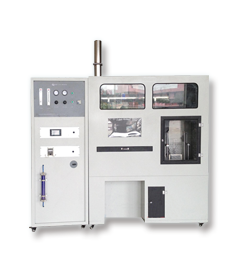
NewsInformation Center
The 5 main processes of Cone Calorimeter
2022/03/28
The main working principle of Cone Calorimeter is the principle of oxygen consumption. When the sample is burned under the thermal radiation of the conical electric heater, the flame will consume a certain concentration of oxygen in the air and release a certain calorific value of combustion. Through a large number of experimental tests and calculation studies, it is believed that the oxygen consumption calorific value of most of the tested materials is close to the average value of 13.1MJ/kg, with a deviation of about 5%.
Cone calorimetry is based on this point, calculating and measuring parameters such as heat release rate and mass loss rate during the combustion process according to the amount of oxygen consumed by the material during combustion, to analyze and judge the combustion performance of the material.
Test Conditions
1. Preparation of sample pieces
The sample piece tested by cone calorimetry should be a square with a complete shape and uniform material quality, a size of 100mm × 100mm, a thickness of 3 to 20mm, and a commonly used thickness of 4 and 10mm.
Sample pieces can be pressed with molds or cut from finished sheets. In short, no matter which way the sample parts are made, there must be no uneven thickness, large and small bubbles, pits and defective materials, and uneven surrounding unevenness. Especially for the sample pieces pressed by the mold, when the material is mixed or stirred, it should be repeated several times on the equipment to fully ensure that the material can be mixed evenly. In this way, the material of the pressed sample can be guaranteed to be uniform, the effect is stable during the combustion test, and the data repeatability is good.

Typically, the sample pieces to be tested should be selected for the same thickness for comparison. It is best to prepare more than 2 pieces of each sample to be tested. Before testing the sample piece, wrap its 5 sides with aluminum foil to prevent excessive dripping and inaccurate testing during burning. A large exposed surface is used to mark the number, receive radiant heat, and observe the test phenomenon.
2. Sample burning box
The sample combustion box is made of heat-resistant stainless steel and is an important part of the test sample. Its shape and size have clear regulations and requirements, and it is a random accessory. The sample combustion box is composed of a box cover, a box body and a lining layer. Before the sample combustion test, the inside and outside of the sample combustion box should be cleaned up, and there should be no debris attached to the box cover and box body. If there is any adherent on the sample combustion box, when the test sample is burned, it will melt and fall off irregularly, which will affect the authenticity of the collected data and loss of quality, resulting in inaccurate experimental results.
The liner layer in the sample combustion box is also very important, which mainly plays the role of thermal insulation and adjustment of the height of the sample piece. The height of the backing layer and the test sample after stacking should be the same as the lower surface inside the top of the box lid, otherwise, the height of the backing layer should be adjusted.
3. Filter material
In the combustion test of cone calorimetry, the material of the filter is very important to the sampling quality and data accuracy, which directly affects the success or failure of the experimental results. Therefore, enough attention should be paid to the quality selection and timely replacement of filter materials, especially before the sample combustion test, it must be fully prepared. To prevent the failure of the test due to poor filtration effect, poor airflow, and blockage of the pipeline during the test process.
4. Approved distance
The distance between the sample piece to be tested and the cone heater is specified as 25mm. When the sample is initially tested, the combustion box is placed on the combustion rack, and the distance between the bottom surface of the conical heater (when the protective plate is opened) and the exposed surface of the sample should be ensured to be 25mm. If the distance is not correct, it should be Adjust in time. There is a protruding adjustment screw at the pole on the load cell, and the distance can be adjusted by moving the sliding sleeve up and down after loosening the screw.
5. Test Calibration
Cone Calorimeter must be calibrated before burning test. The calibration items include mass calibration, oxygen analyzer calibration, radiation power calibration, laser smoke measurement calibration and thermal coefficient "C" value calibration. Only after the above-mentioned parameters have been calibrated, can the computer perform effective arithmetic processing on the data collected during the burning test of the sample. The calibration parameters must meet the requirements and reach the accuracy range of the instrument in order to obtain better calibration data and conduct the experimental test smoothly.
QINSUN is a professional Cone Calorimeter exporter. Our products sell well all over the world and have won unanimous praise from customers. If you have friends who buy, please leave us a message!
Previous: Specifications and Features of Dry microbial penetration tester
N e x t : Air Permeability Tester test sportswear breathability analysis



